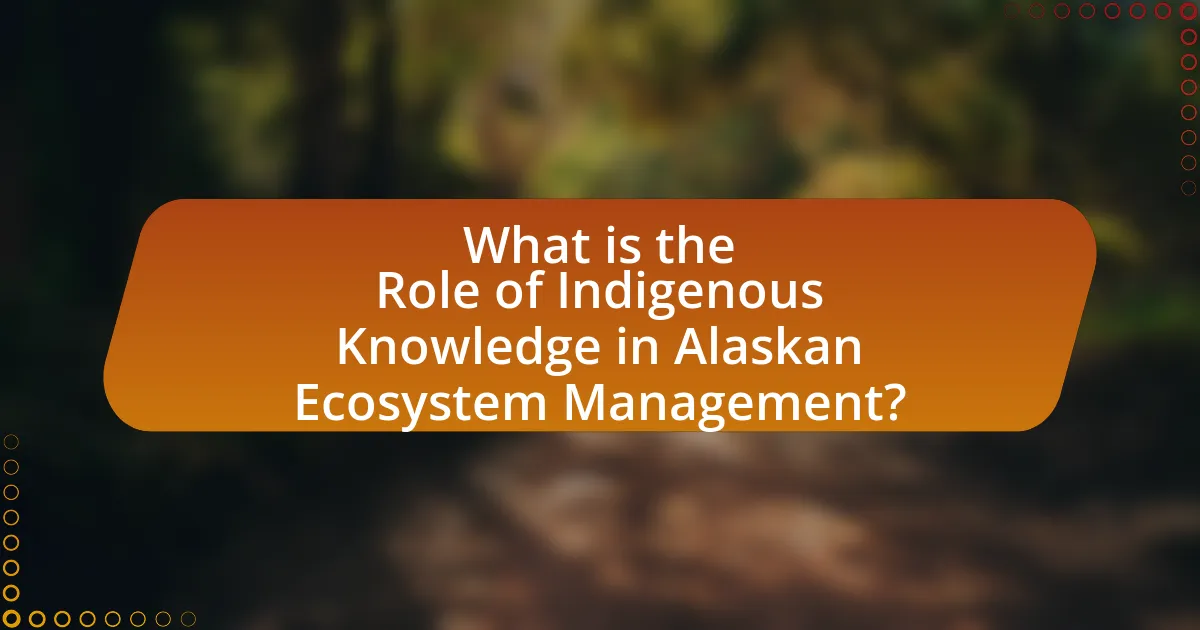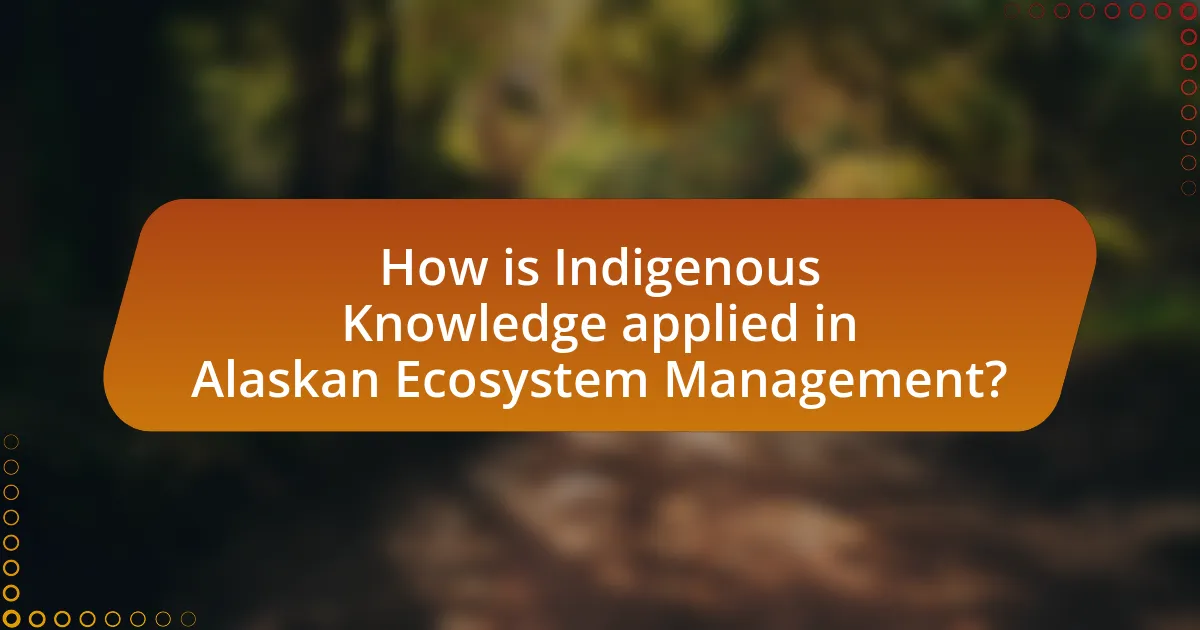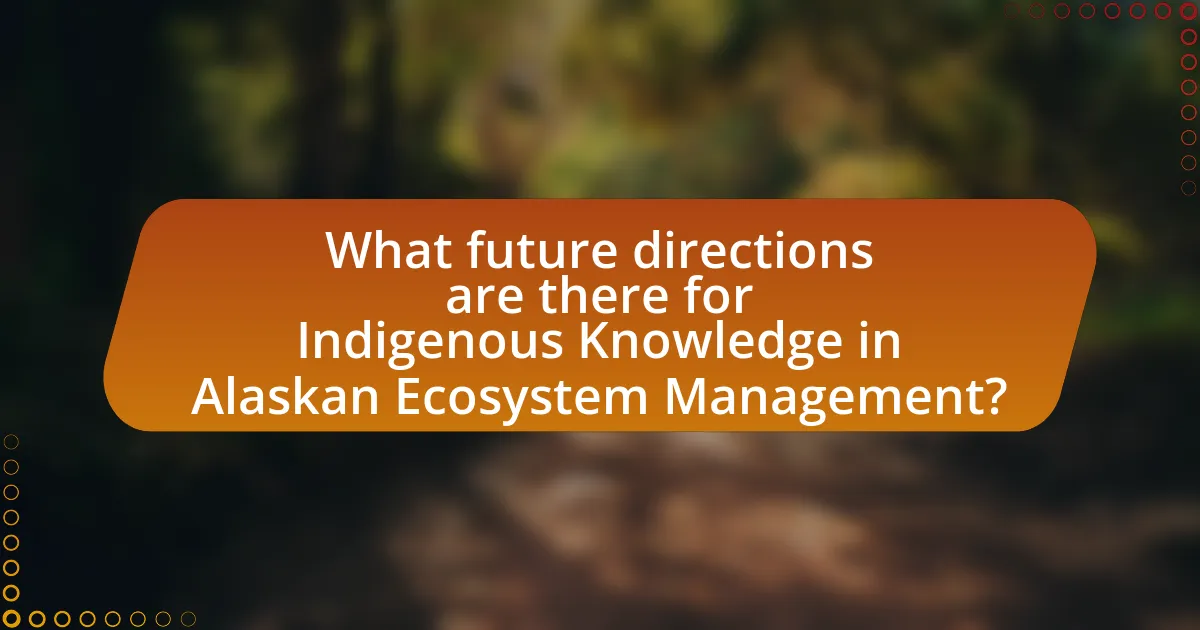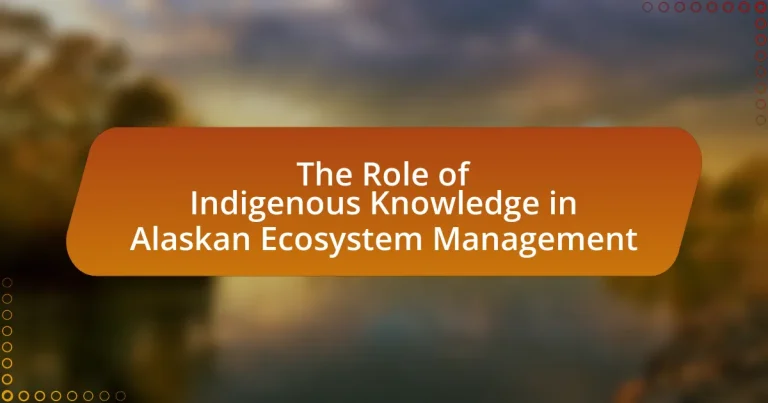The article examines the critical role of Indigenous Knowledge in the management of Alaskan ecosystems, highlighting its significance in sustainable practices and ecological relationships developed over millennia. It defines Indigenous Knowledge as a cumulative body of insights that informs local ecosystem understanding and resource management, emphasizing principles such as community-based knowledge sharing and respect for traditional practices. The article contrasts Indigenous approaches with Western scientific methods, discusses the unique insights Indigenous Knowledge provides for biodiversity conservation, and addresses the challenges faced in integrating this knowledge into mainstream management strategies. Additionally, it explores the benefits of co-management approaches and the importance of education in promoting Indigenous perspectives within ecosystem management frameworks.

What is the Role of Indigenous Knowledge in Alaskan Ecosystem Management?
Indigenous knowledge plays a crucial role in Alaskan ecosystem management by providing insights into sustainable practices and ecological relationships developed over thousands of years. This knowledge encompasses traditional ecological knowledge (TEK), which includes understanding species behavior, seasonal changes, and land management techniques that have been passed down through generations. For instance, Indigenous communities have historically managed fish and wildlife populations through practices that align with natural cycles, contributing to biodiversity conservation. Research indicates that integrating Indigenous knowledge with scientific approaches enhances resource management effectiveness, as seen in the collaborative efforts between Indigenous groups and state agencies in managing salmon populations, which have shown improved outcomes in both ecological health and community well-being.
How is Indigenous Knowledge defined in the context of ecosystem management?
Indigenous Knowledge in the context of ecosystem management is defined as the cumulative body of knowledge, practices, and beliefs developed by Indigenous peoples over generations, which informs their understanding of local ecosystems and sustainable resource management. This knowledge encompasses traditional ecological practices, cultural values, and a deep connection to the land, enabling Indigenous communities to manage natural resources effectively. For instance, studies have shown that Indigenous land management practices, such as controlled burns, enhance biodiversity and ecosystem resilience, demonstrating the practical application and validity of Indigenous Knowledge in contemporary ecosystem management strategies.
What are the key principles of Indigenous Knowledge?
The key principles of Indigenous Knowledge include a deep connection to the land, holistic understanding of ecosystems, community-based knowledge sharing, and respect for traditional practices. These principles emphasize the interdependence of humans and nature, recognizing that ecological balance is maintained through sustainable practices informed by generations of experience. For instance, Indigenous communities in Alaska utilize traditional ecological knowledge to manage resources sustainably, which has been shown to enhance biodiversity and resilience in local ecosystems. This approach is supported by research indicating that Indigenous management practices can lead to better environmental outcomes compared to conventional methods.
How does Indigenous Knowledge differ from Western scientific approaches?
Indigenous Knowledge differs from Western scientific approaches primarily in its holistic and experiential nature, emphasizing relationships with the environment over empirical data collection. Indigenous Knowledge is rooted in cultural traditions, oral histories, and long-term observations of local ecosystems, which provide a deep understanding of ecological dynamics. In contrast, Western scientific approaches often prioritize quantitative analysis, controlled experiments, and reproducibility, focusing on isolating variables to understand natural phenomena. This distinction is evident in Alaskan ecosystem management, where Indigenous Knowledge incorporates community values and ecological stewardship, while Western science may overlook these social dimensions in favor of technical assessments.
Why is Indigenous Knowledge important for Alaskan ecosystems?
Indigenous Knowledge is crucial for Alaskan ecosystems because it encompasses centuries of observations and practices that enhance environmental stewardship and biodiversity management. This knowledge includes traditional ecological practices, such as sustainable hunting, fishing, and gathering, which have been adapted to local conditions and species. For instance, Indigenous communities have developed intricate understanding of seasonal changes and animal behaviors, which informs conservation strategies and resource management. Studies have shown that integrating Indigenous Knowledge with scientific approaches leads to more effective ecosystem management, as evidenced by successful co-management initiatives in Alaska that have improved fish populations and habitat restoration efforts.
What unique insights does Indigenous Knowledge provide about local ecosystems?
Indigenous Knowledge offers unique insights into local ecosystems by emphasizing the interconnectedness of species and their environments, which is often informed by centuries of observation and experience. This knowledge includes detailed understanding of seasonal changes, animal behaviors, and plant growth patterns, which are critical for sustainable resource management. For instance, Indigenous communities in Alaska have documented the migratory patterns of caribou and the seasonal availability of fish, providing valuable data that can enhance modern ecological studies and conservation efforts. Such insights are supported by research indicating that Indigenous practices contribute to biodiversity conservation and ecosystem resilience, as highlighted in studies by the Alaska Native Science Commission.
How does Indigenous Knowledge contribute to biodiversity conservation?
Indigenous Knowledge contributes to biodiversity conservation by integrating traditional ecological practices with contemporary conservation strategies. This knowledge encompasses a deep understanding of local ecosystems, species interactions, and sustainable resource management, which has been developed over generations. For instance, Indigenous communities in Alaska utilize traditional practices such as seasonal harvesting and habitat stewardship, which promote the resilience of local species and ecosystems. Research indicates that areas managed by Indigenous peoples often exhibit higher biodiversity levels compared to those under conventional management, highlighting the effectiveness of these traditional methods in maintaining ecological balance.
What challenges does Indigenous Knowledge face in ecosystem management?
Indigenous Knowledge faces challenges in ecosystem management primarily due to the lack of recognition and integration within formal scientific frameworks. This marginalization often leads to the undervaluation of traditional ecological practices that have been developed over generations. For instance, many Indigenous communities possess extensive knowledge about local biodiversity and sustainable practices, yet their insights are frequently overlooked in policy-making processes. Additionally, there is often a disconnect between Indigenous Knowledge systems and Western scientific approaches, which can hinder collaborative efforts in ecosystem management. This challenge is compounded by external pressures such as climate change and resource extraction, which threaten traditional lands and practices, further diminishing the role of Indigenous Knowledge in effective ecosystem management.
How do modern environmental policies impact Indigenous practices?
Modern environmental policies often restrict Indigenous practices by imposing regulations that prioritize conservation and resource management over traditional ecological knowledge. These policies can limit access to land and resources that Indigenous communities rely on for cultural and subsistence activities, undermining their traditional practices. For instance, the establishment of protected areas can prevent Indigenous peoples from engaging in hunting, fishing, and gathering, which are integral to their cultural identity and livelihood. Additionally, policies that do not incorporate Indigenous knowledge may lead to ineffective management strategies that fail to recognize the sustainable practices developed over generations by these communities.
What are the barriers to integrating Indigenous Knowledge into mainstream management strategies?
Barriers to integrating Indigenous Knowledge into mainstream management strategies include institutional resistance, lack of recognition, and differing worldviews. Institutional resistance often stems from bureaucratic structures that prioritize scientific data over traditional ecological knowledge, leading to a marginalization of Indigenous perspectives. Lack of recognition occurs when Indigenous Knowledge is not formally acknowledged or valued within management frameworks, resulting in exclusion from decision-making processes. Additionally, differing worldviews create challenges, as mainstream management often operates under a utilitarian perspective, while Indigenous Knowledge encompasses holistic and relational understandings of ecosystems. These barriers hinder effective collaboration and the incorporation of diverse knowledge systems in ecosystem management.

How is Indigenous Knowledge applied in Alaskan Ecosystem Management?
Indigenous Knowledge is applied in Alaskan Ecosystem Management through the integration of traditional ecological practices and local cultural insights into contemporary resource management strategies. This approach enhances biodiversity conservation, as Indigenous communities possess a deep understanding of local ecosystems, species behavior, and seasonal changes, which has been developed over thousands of years. For example, the use of Indigenous Knowledge in fisheries management has led to sustainable practices that align with the natural cycles of fish populations, ensuring long-term viability. Studies, such as those conducted by the Alaska Native Science Commission, demonstrate that incorporating Indigenous perspectives can improve decision-making processes and outcomes in ecosystem management, ultimately leading to more resilient and adaptive management strategies.
What are some examples of Indigenous practices in ecosystem management?
Indigenous practices in ecosystem management include controlled burning, traditional ecological knowledge, and sustainable harvesting techniques. Controlled burning, used by various Indigenous groups, helps to manage vegetation and reduce the risk of larger wildfires, as evidenced by practices among the Yurok Tribe in California. Traditional ecological knowledge encompasses the understanding of local ecosystems gained over generations, guiding resource management decisions, such as the seasonal migration patterns of fish and wildlife. Sustainable harvesting techniques, like the selective gathering of plants and animals, ensure that resources are available for future generations, as demonstrated by the subsistence practices of Alaskan Native communities. These practices are rooted in a deep understanding of the land and its ecosystems, contributing to biodiversity conservation and resilience against climate change.
How do traditional hunting and fishing practices support sustainable management?
Traditional hunting and fishing practices support sustainable management by promoting ecological balance and resource conservation. These practices are often guided by generations of indigenous knowledge that emphasize the importance of maintaining healthy populations of wildlife and fish, ensuring that harvesting does not exceed natural replenishment rates. For instance, the Alaska Native community employs seasonal hunting and fishing methods that align with the life cycles of species, such as the timing of salmon runs, which helps to sustain fish populations. Additionally, traditional practices often include the use of selective harvesting techniques that minimize impact on the ecosystem, such as taking only mature animals or fish, thereby allowing younger populations to thrive and reproduce. This approach not only preserves biodiversity but also fosters resilience in the ecosystem, as evidenced by studies showing that indigenous management practices can lead to more stable and productive environments compared to industrial methods.
What role does storytelling play in the transmission of Indigenous ecological knowledge?
Storytelling serves as a fundamental mechanism for transmitting Indigenous ecological knowledge, as it encapsulates cultural values, environmental observations, and practical survival strategies. Through narratives, Indigenous peoples convey complex relationships with their ecosystems, including seasonal changes, animal behaviors, and sustainable practices. For instance, oral traditions often include specific stories about local flora and fauna, which not only educate younger generations but also reinforce community identity and stewardship of the land. Research indicates that storytelling enhances memory retention and understanding, making it an effective educational tool in Indigenous cultures, where formal written records may be absent.
How do Indigenous communities collaborate with scientists and policymakers?
Indigenous communities collaborate with scientists and policymakers through co-management agreements, participatory research, and knowledge sharing. These collaborations often involve Indigenous knowledge systems being integrated into scientific research, which enhances ecosystem management strategies. For instance, the Alaska Native Claims Settlement Act of 1971 established a framework for Indigenous participation in land management, allowing for the incorporation of traditional ecological knowledge into state and federal policies. This partnership has been shown to improve biodiversity conservation efforts and climate resilience, as evidenced by various studies highlighting the effectiveness of Indigenous practices in sustainable resource management.
What are the benefits of co-management approaches in Alaska?
Co-management approaches in Alaska provide significant benefits, including enhanced resource sustainability, improved decision-making, and strengthened community engagement. These collaborative frameworks allow Indigenous communities to integrate traditional ecological knowledge with scientific research, leading to more effective management of natural resources. For instance, studies have shown that co-management can result in better fishery outcomes, as local knowledge contributes to understanding species behavior and habitat conditions. Additionally, co-management fosters a sense of ownership and responsibility among local populations, which can lead to increased compliance with regulations and conservation efforts.
How can partnerships enhance the effectiveness of ecosystem management?
Partnerships enhance the effectiveness of ecosystem management by integrating diverse knowledge systems, particularly Indigenous knowledge, which provides valuable insights into local ecosystems. Collaborative efforts between Indigenous communities, government agencies, and conservation organizations lead to more holistic management strategies that respect cultural practices and ecological wisdom. For instance, studies have shown that incorporating Indigenous perspectives can improve biodiversity outcomes and resilience against climate change, as seen in various Alaskan initiatives where traditional ecological knowledge has been applied to inform sustainable practices. This synergy not only fosters community engagement but also ensures that management practices are culturally relevant and scientifically sound, ultimately leading to more effective ecosystem stewardship.
What role does education play in promoting Indigenous Knowledge?
Education plays a crucial role in promoting Indigenous Knowledge by facilitating the transmission and integration of traditional ecological practices into contemporary environmental management. Through educational programs, Indigenous communities can share their unique perspectives on sustainable practices, biodiversity, and ecosystem stewardship, which are often rooted in centuries of experience and observation. For instance, research conducted by the University of Alaska Fairbanks highlights that incorporating Indigenous Knowledge into formal education systems enhances the understanding of local ecosystems and fosters respect for traditional practices among non-Indigenous students. This integration not only validates Indigenous perspectives but also enriches scientific approaches to ecosystem management, leading to more effective conservation strategies.
How can educational programs incorporate Indigenous perspectives?
Educational programs can incorporate Indigenous perspectives by integrating traditional ecological knowledge (TEK) into the curriculum. This approach acknowledges the value of Indigenous ways of knowing, which have been developed over thousands of years and are crucial for understanding local ecosystems. For instance, programs can include collaboration with Indigenous communities to co-develop educational materials that reflect their cultural practices and environmental stewardship. Research shows that TEK can enhance biodiversity conservation efforts, as demonstrated in studies like “Indigenous Knowledge and Its Role in Ecosystem Management” published in the Journal of Environmental Management, which highlights successful case studies in Alaska where Indigenous practices have led to improved ecosystem outcomes.
What impact does education have on community engagement in ecosystem management?
Education significantly enhances community engagement in ecosystem management by equipping individuals with the knowledge and skills necessary to participate effectively. When communities are educated about local ecosystems, they become more aware of environmental issues, which fosters a sense of responsibility and encourages active participation in management practices. For instance, studies have shown that educational programs focused on indigenous knowledge and sustainable practices lead to increased involvement in conservation efforts, as seen in various Alaskan communities where traditional ecological knowledge is integrated into formal education. This integration not only empowers community members but also strengthens the collaboration between local populations and management authorities, resulting in more effective ecosystem stewardship.

What future directions are there for Indigenous Knowledge in Alaskan Ecosystem Management?
Future directions for Indigenous Knowledge in Alaskan Ecosystem Management include integrating traditional ecological knowledge (TEK) into contemporary resource management practices. This integration can enhance biodiversity conservation and climate resilience by utilizing Indigenous perspectives on land stewardship, which have been developed over thousands of years. Research indicates that incorporating TEK can lead to more effective management strategies, as seen in the work of the Alaska Native Science Commission, which emphasizes the importance of local knowledge in addressing environmental changes. Additionally, collaborative frameworks that involve Indigenous communities in decision-making processes are essential for sustainable ecosystem management, as they ensure that cultural values and practices are respected and utilized.
How can Indigenous Knowledge be preserved for future generations?
Indigenous Knowledge can be preserved for future generations through documentation, intergenerational teaching, and community engagement. Documentation involves recording traditional practices, stories, and ecological knowledge in written or digital formats, ensuring that this information is accessible. Intergenerational teaching emphasizes the importance of elders passing down knowledge to younger community members, fostering a deep understanding of cultural practices and environmental stewardship. Community engagement encourages collaborative efforts among Indigenous groups, researchers, and policymakers to integrate Indigenous perspectives into ecosystem management, thereby validating and sustaining this knowledge within contemporary frameworks. These methods collectively contribute to the resilience and continuity of Indigenous Knowledge in the context of Alaskan ecosystem management.
What strategies can be implemented to document and share Indigenous Knowledge?
To document and share Indigenous Knowledge, strategies such as collaborative partnerships, digital archiving, and community-led workshops can be implemented. Collaborative partnerships between Indigenous communities and researchers facilitate the co-creation of knowledge, ensuring that Indigenous perspectives are respected and accurately represented. Digital archiving allows for the preservation of oral histories, traditional practices, and ecological knowledge, making it accessible to a wider audience while protecting the integrity of the information. Community-led workshops empower Indigenous peoples to share their knowledge directly, fostering intergenerational learning and cultural continuity. These strategies are supported by the recognition that Indigenous Knowledge is vital for sustainable ecosystem management, as highlighted in studies like “Indigenous Knowledge and Ecosystem Management” by Berkes et al., which emphasizes the importance of integrating traditional ecological knowledge with scientific approaches for effective environmental stewardship.
How can technology aid in the preservation of Indigenous ecological practices?
Technology can aid in the preservation of Indigenous ecological practices by facilitating the documentation, sharing, and application of traditional knowledge. Digital platforms enable Indigenous communities to record their ecological practices, ensuring that valuable information is not lost over generations. For instance, Geographic Information Systems (GIS) allow for the mapping of traditional land use and resource management practices, which can be used to inform sustainable practices and policy decisions. Additionally, mobile applications can help in the collection of data on local biodiversity and environmental changes, empowering Indigenous communities to adapt their practices based on real-time information. Research indicates that integrating technology with Indigenous knowledge enhances community resilience and supports the sustainable management of ecosystems, as seen in various projects across Alaska where technology has been used to document and revitalize traditional ecological knowledge.
What are the best practices for integrating Indigenous Knowledge into ecosystem management?
The best practices for integrating Indigenous Knowledge into ecosystem management include establishing collaborative partnerships with Indigenous communities, recognizing and respecting traditional ecological knowledge, and incorporating Indigenous perspectives into decision-making processes. Collaborative partnerships ensure that Indigenous voices are included in management strategies, fostering mutual respect and understanding. Recognizing traditional ecological knowledge involves valuing the historical and cultural context of Indigenous practices, which can enhance biodiversity conservation efforts. Incorporating Indigenous perspectives into decision-making processes allows for a holistic approach to ecosystem management, as evidenced by successful case studies in Alaska where Indigenous practices have led to improved resource management and sustainability outcomes.
How can stakeholders ensure respectful collaboration with Indigenous communities?
Stakeholders can ensure respectful collaboration with Indigenous communities by actively engaging in meaningful dialogue and recognizing the value of Indigenous knowledge systems. This involves establishing trust through consistent communication, honoring traditional practices, and involving Indigenous representatives in decision-making processes. Research indicates that projects incorporating Indigenous perspectives lead to more sustainable outcomes, as seen in the Alaska Native Claims Settlement Act, which emphasizes the importance of Indigenous input in land management. By prioritizing these approaches, stakeholders can foster a collaborative environment that respects and integrates Indigenous cultural values and ecological knowledge.
What frameworks exist for evaluating the effectiveness of Indigenous Knowledge integration?
Frameworks for evaluating the effectiveness of Indigenous Knowledge integration include the Participatory Action Research (PAR) framework, the Two-Eyed Seeing approach, and the Indigenous Knowledge Systems framework. The Participatory Action Research framework emphasizes collaboration between Indigenous communities and researchers, ensuring that local knowledge is integrated into decision-making processes. The Two-Eyed Seeing approach, developed by Mi’kmaq scholar Albert Marshall, combines Indigenous and Western scientific perspectives to create a more holistic understanding of ecosystems. The Indigenous Knowledge Systems framework focuses on the unique cultural contexts and practices of Indigenous peoples, allowing for tailored evaluation methods that respect traditional knowledge. These frameworks have been validated through various case studies demonstrating improved ecosystem management outcomes when Indigenous Knowledge is effectively integrated.
What practical steps can be taken to enhance the role of Indigenous Knowledge in ecosystem management?
To enhance the role of Indigenous Knowledge in ecosystem management, integrating Indigenous perspectives into policy-making and management practices is essential. This can be achieved by establishing collaborative frameworks that involve Indigenous communities in decision-making processes, ensuring their traditional ecological knowledge is recognized and valued. For instance, the incorporation of Indigenous land management practices, such as controlled burns used by Alaskan Native tribes, has been shown to improve biodiversity and ecosystem resilience. Furthermore, training programs that educate both Indigenous and non-Indigenous stakeholders about the significance of Indigenous Knowledge can foster mutual respect and understanding, leading to more effective ecosystem management strategies.


